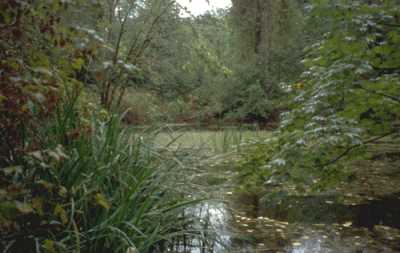Cedar River Oxbow Wetland 79 Enhancement Project

In 1999 King County began an enhancement and restoration project along the Cedar River, in King County, WA. Restoration activities were jointly funded by King County and a grant from Washington State Department of Natural Resources ALEA grant program.
The goal of this project is to protect and restore Wetland 79, a high-quality oxbow wetland, one of the few still connected to the lower Cedar River. Restoration activities were jointly funded by King County and a grant from Washington State Department of Natural Resources.
Site and project history

The site includes a 2-acre pond and wetland complex. Oxbows are often naturally formed when bends in a river are cut off from the river when the main channels move, though this oxbow was formed when the Burlington Northern Railroad constructed a raised railroad bed and shifted the alignment of the Cedar River to the north.
Also, in this instance, the oxbow was not cut off completely from the river but remained connected through a culvert under the railroad bed.

In last few decades a house was built in the wetland buffer, portions of the wetland were filled in and livestock had access to the pond. Additionally, this connection became increasingly unusable by fish because of blocking of the culverts by beaver dams.
Restoration activities

Restoration efforts first began on the site in 1995, when fish passage between the pond and the river was reestablished by installing a beaver-proof fishway at the inlet to the culvert.
The current restoration project includes the following activities:
- Purchase of property in 1998. The site had been flooded in the 1995-96 winter storm when Rock Creek overflowed its channel and created a stream running down the drive way.
- The house on the property was flooded with 6 - 8 feet of water and was damaged to an extent that it could not be repaired. The house was removed from the site in 1999.
- In 2000 restoration activities consisted of:
- removing fill placed in the wetland,
- removing silt from a portion of the oxbow channel, and
- enlarging the fish-spawnable area of the wetland by connecting a finger of the open water wetland to a spring-fed pond located on an adjacent piece of property.
- Large woody debris (LOD) consisting of logs, rootwads, and logs with rootwads were added to the wetland in the newly constructed channel to increase habitat complexity.
Benefits of the proposed project
- Restoration of a high-quality wetland for education purposes - the site will be used for guided tours and education.
- Increased habitat available for salmon spawning, primarily sockeye.
- Increased area for rearing and overwintering for coho salmon.
- Potential for improved flood refuge habitat for chinook salmon.
- Protection of existing high-value aquatic habitat.
- Re-establishment of aquatic riparian areas.
To learn more
Collaborating organizations
- Washington State Department of Natural Resources
- King County Department of Natural Resources
- King County Park System
- University of Washington, School of Aquatic and Fisheries Science
- Washington Conservation Corp
For questions about the Wetland 79 project, please contact Jon Hansen, Senior Ecologist.

 Translate
Translate